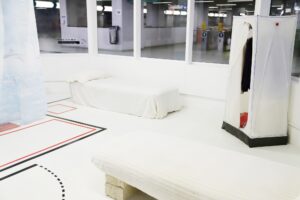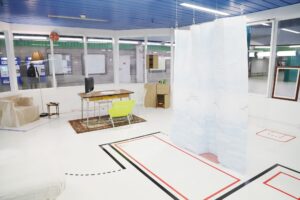To live is to move from one space to another while trying not to hurt oneself too much.. (G. Perec, Specie di spazi, 1974)
In an article published on The Guardian on 17/09/2008[1], journalist Lucy Mangan attempts an interpretation of some photographs, portraying the so-called empty-deskers: American yuppies leaving their offices after the bankruptcy of their now former company. This is Lehman Brothers, trigger of the most virulent global financial crisis since the 1929 Wall Street collapse.

Zeroscena and Silvia Francis Berry, “AFFITTASI LUMINOSISSIMO BILOCALE”, installation view at spazioSERRA, 2024, courtesy spazioSERRA
‘Why so many smiles?’ we can read from the photograph of a former employee smiling at the camera. It is a question that betrays the ambiguity of these images, suspended between the perception of the impending crisis and the virtuality of moments too particular to be fully understood. Disturbing moments: somewhere between real and imagined, between an indeterminable big picture and moments experienced with deliberate, fictitious innocence, following the same contradiction as that crisis which, a year earlier, had begun with the housing emergency and the collapse of high-risk subprime mortgages, in the interweaving of real estate reality and speculation. In this brief incipit, certain concepts emerge – reality, speculation, home – that allow us to frame the meaning of AFFITTASI LUMINOSISSIMO BILOCALE, the exhibition by Zeroscena collective (Elisa La Boria, Luka Bagnoli) and Silvia Francis Berry, curated by spazioSERRA in the frame of suMISURA, the 2024 exhibition season designed by the eponymous curatorial collective, which continues to explore the relationship between art and public project, keeping the former octagonal glass kiosk of Lancetti station in Milan as its focal point.

Zeroscena and Silvia Francis Berry, “AFFITTASI LUMINOSISSIMO BILOCALE”, installation view at spazioSERRA, 2024, courtesy spazioSERRA
Within AFFITTASI LUMINOSISSIMO BILOCALE, the latter really becomes a flat. Or rather, the simulacrum of it, as real as it is fictitious: neatly scanned by imagining a daily routine made up of beds, chairs, toilet, cardboard kitchen, study-table, wardrobe and no dividing wall. Instead, the daily rhythm would be marked by the sharp lines of a floor plan that contours these objects, geometrizing their functionality by frictioning its abstract language with the imperfect language of things, all retrieved from family members or online ads aimed at getting rid of these everyday life excrescences. Like them, the two-room apartment in spazioSERRA looks like an excrescence: a provocative aesthetic protuberance extracted from the body of the rental market crisis, afflicting Milan and other Italian cities. Between volatile prices and rooms that do not correspond to their market value, along with speculation and growing demand weighing on students and precarious workers, the scenario fuels the short-circuit between attractiveness and structural inequality that the exhibition stages, while maintaining its underlying coordinates. The seduction of spazioSERRA showcase consciously enters into friction with the disturbing calm – playful and cruel – of a motionless and awkwardly grotesque domestic space, which silently exposes the measured calculus of a deranged and transitory living.

Zeroscena and Silvia Francis Berry, “AFFITTASI LUMINOSISSIMO BILOCALE”, installation view at spazioSERRA, 2024, courtesy spazioSERRA
Concerning the housing emergency, the exhibition extracts not so much the daily news as the underlying grammar, the sensitive coordinates of that housing unease evoked by things that become signs of themselves: the concrete alphabet of a problematic, saturated space. In their critical reflection, Alice Nagini and Laura Raccanelli ask: «What, then, is home? The people who inhabit it, the place where one lives, or the things that make it up? And what, instead, does unmake a home?». For their side, the artists seem to respond tying to the words by George Perec, who in Species of spaces (1974) writes: «Space seems to be, either more domesticated, or more inoffensive than time. […] One always needs to know the time […] but one never asks where one is. One thinks one knows […] It is obvious, of course – but what is not obvious? Yet, from time to time, one should ask oneself where one has (arrived) […].

Zeroscena and Silvia Francis Berry, “AFFITTASI LUMINOSISSIMO BILOCALE”, installation view at spazioSERRA, 2024, courtesy spazioSERRA
Ask yourself where you are, but how? By installing a 1:1 scale diorama of the housing crisis, making the transition – the one inherent in contemporary living – a domesticity to be traversed with irony and suspicion. Zeroscena’s research, focused on the potential of play and magic realism (translated into investigative fantasy) emerges here, as Silvia Francis Barry’s drawing does, which infuses the space with a childlike gestuality and pragmatic naivety, while designing the planimetric contours of this fictitious scenario. In relation to the current crisis, the exhibition is placed in a slightly out-of-phase space. Although in a different context, it shares the same ambiguity as the images of empty-deskers somewhere between smiles and disquiet and intercepts an equally insidious kind of housing instability. The problem of living returns in all its urgency. Zeroscena and Francis Barry respond with their very- two-room apartment (very bright, very tidy, etc.) addressing the question towards more capillary and complex dimensions, to search for decisive practices in the interstice between personal and collective crisis.
[1] Full article available here: https://www.theguardian.com/business/gallery/2008/sep/17/lehmanbrothers.creditcrunch
Info:
Zeroscena e Silvia Francis Berry. AFFITTASI LUMINOSISSIMO BILOCALE
curated by spazioSERRA
15/02/2024 – 22/03/2024
spazioSERRA
Stazione Milano Lancetti – Viale Vincenzo Lancetti 43, Milano
https://www.spazioserra.org/it

Piermario De Angelis was born in Pescara on 06/10/1997. After graduating from high school he moved to Milan to attend the three-year degree course in Arts, Design and Entertainment at the IULM university. He is currently a second year student of the two-year course of Visual Cultures and Curatorial Practices at the Brera Academy of Fine Arts. He is a contributor for ‘Juliet Art Magazine’ and ‘Kabul Magazine’. In 2021 he co-founded, together with other students of the Brera Academy, the non-profit cultural association Genealogie Del Futuro: a reality that addresses socio-political and environmental issues through alternative community building practices, through an artistic and curatorial perspective. His research aims to be an exploration of the critical potential of art and images in relation to the urgencies of contemporaneity.






NO COMMENT